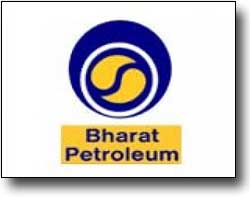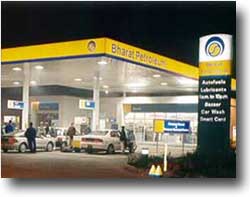Birth of the Company
Bharat Petroleum Corporation Limited forms a new chapter in the history of Indian industry. Petroleum (derived from Latin Petra - rock and oleum - oil) first came up in wells drilled for salt. People found it useful as illuminating oil and the demand for it steadily increased. Samuel Kier, a Pittsburgh druggist, had bottled and marketed Petroleum as a medicinal cure. To market a deodorised variant, the company had designed the first primitive refinery in 1852, which was a huge improvised kettle, connected to a metal tank. 'Colonel' Edwin Drake and 'Uncle' Billy Smith drilled a well with the specific objective of finding oil, and on 27th August 1859, they 'struck oil' at Titusvale, in North Western Pennsylvania, USA, at a depth of 69.5 ft.

While discoveries were made and industries had been expanded, John D Rockefeller together with his business associates acquired control over numerous refineries and pipelines to later form the giant Standard Oil Trust. In 1928, Asiatic Petroleum (India) joined hands with Burmah Oil Company - an active producer, refiner and distributor of petroleum products, particularly in Indian and Burmese markets. This alliance had led to the formation of Burmah-Shell Oil Storage and Distributing Company of India Limited.
The Pioneering Spirit - Burmah Shell Marketing
A pioneer in more ways than one, Burmah Shell began its operations with import and marketing of Kerosene. This was imported in bulk and transported in 4 gallon and 1 gallon tins through rail, road and country craft all over India. The company took up the challenge of reaching out to the people even in the remote villages to ensure every home had its supply of kerosene. The development and promotion of the most efficient kerosene-burning appliances for lighting and cooking was an important part of kerosene selling activity.
With motor cars, came canned Petrol, followed by service stations. In the 1930's, retail sales points were built with driveways set back from the road; service stations began to appear and became accepted as a part of road development. After the war Burmah Shell was established in an efficient and up-to-date service and filling stations to give the customers the highest possible standard of service facilities.
On 15th October 1932, when civil aviation arrived in India, the company had the honour of fuelling J.R.D. Tata's historic solo flight in a single engined de Havillian Puss Moth from Karachi to Bombay (Juhu) via Ahmedabad. Thirty years later, i.e. in 1962, Burmah Shell again had the privilege to fuel JRD Tata's re-enactment of the original flight. Burmah Shell also fuelled flying boats, which carried air-mail at slightly higher rates than sea transport, at several locations.
Shaping the Future
The core strength of Bharat Petroleum Corporation Limited has always been the ardent pursuit of qualitative excellence for maximisation of customer satisfaction. Thus Bharat Petroleum, the erstwhile Burmah Shell, has today become one of the most formidable names in the petroleum industry. Bharat Petroleum produces a diverse range of products, from petrochemicals and solvents to aircraft fuel and speciality lubricants and markets them through its wide network of Petrol Stations, Kerosene Dealers, LPG Distributors, Lube Shoppes, besides supplying fuel directly to hundreds of industries, and several international and domestic airlines.
Dynamic growth post nationalisation and also following nationalisation in 1976, Bharat Petroleum changed gears and embarked upon a rapid growth path. Turnover, profitability and financial reserves grew by leaps and bounds. Massive expansion and modernisation provided a tremendous boost to the company's performance. Large-scale recruitment and training became critically important to meet the demands of expansion. A transformed Organisation emerged and the opening up of the Indian economy in the nineties brought with it more competition and challenges, kindled by the phased dismantling of the Administered Pricing Mechanism (APM) and emergence of additional capacities in the region in refining and marketing.
In 1996, Bharat Petroleum went through a process of visioning, involving people at all levels, which evolved a shared vision and a set of shared values. Based on this, the company restructured itself, in a proactive move to adapt to the emerging competitive scenario. The function-based structure was carefully dismantled and replaced with a process-based one. This made the company more responsive to its customer needs.
Bharat Petroleum realises that, in the long run, success can only come with a total reorientation and change in approach with the customer as the focal point. Today, Bharat Petroleum is restructured into a Corporate Centre, Strategic Business Units (SBUs) and Shared Services and Entities. The organisational design comprises of five customers facing SBUs, viz. Aviation, Industrial and Commercial, LPG, Lubricants and Retail and one asset based SBU, viz. Refinery, is based on the philosophy of greater customer focus.
The Planned Approach: Increasing globalisation, new products and services, and innovative marketing have resulted in a very market savvy consumer. The production-based success philosophy of marketers is now replaced by a customer-oriented philosophy. Bharat Petroleum has taken cognisance of this particular situation well in time and has been taking radical steps to keep itself attuned to the changing times, realising that the future belongs to those who listen and adapt to their customers.
Strategy Development: the organization recognises that all strategic initiatives must conform to the overall vision of the Corporation and mostly to improve the economic value. The Strategy Development effort at the corporate level had achieved better focus in the new organisational structure, besides facilitating the SBUs in developing their respective strategies that lead to an integrated Corporate Strategy. A Business Planning process has been put in place that not only provides opportunities for the SBU's to pursue their visionary goals in consonance with the Corporate Vision, but also continuously monitors trends and identifies strategic opportunities for the Corporation.
Brand Management: In the highly competitive scenario, it has become very much imperative to own dominant brands. The Brand Management team at Bharat Petroleum endeavours to build and manage a strong brand image reflecting Bharat Petroleum's core values of being 'INCARE', viz. INnovative, CAring and REliable. Emphasis had been laid on continuously understanding customer behaviour, tracking their changing needs and expectations, and meeting these needs in the most cost-effective manner.
Research and Development : Bharat Petroleum is making distinct efforts towards most of the Research and Development. Besides the R and D facilities at the Refinery areas and the Product Application Development Centre in Sewree in Mumbai, a new state-of-the-art R and D Centre is set up nearby Delhi. The R and D Centre is organised around three core groups - Process and Technology Development, Product Application Development and Environmental Engineering.
Human Resources

Awards
Bharat Petroleum was applauded with two prestigious Communication Awards at the Golden Jubilee function of the Annual Association of Business Communicators of India (ABCI) Awards Nite held at the Taj Mahal Hotel, Mumbai on 11th November 2010. Every year, ABCI recognizes and rewards leading corporates for their excellent contribution in the field of Business Communication. In fact, it is a mark of prestige to get an ABCI Award.
BPCL won the Silver Award for its Inhouse Publication, Petro Plus and the Bronze Award for its Online Web Campaign. BPCL shined at Petrotech 02 Nov 2010 intralink. Bharat Petroleum was awarded the 1st position under the "Best Display in Raw Space" category during a spectacular awards ceremony at Petrotech-2010 exhibition at Pragati Maidan, New Delhi.
Its website www.bharatpetroleum.in bagged the first prize in the category 'Most user friendly website' (editors choice) in the India eGov 2.0 Awards 2010. The magazine eGov is Asia's first and only print-cum-online magazine which is on e-Governance.
BPCL is among the Top 10 Valuable Brands in India. A brand led business design is a necessity to deliver on the business' full potential. With a customer centric approach the organization has over the years passionately nurtured Brands and this has resulted in the company enjoying a good status in the Corporate world.
 INDIAN OIL INDUSTRY
INDIAN OIL INDUSTRY
 INDIAN OIL INDUSTRY at a glance in 2014-2015
INDIAN OIL INDUSTRY at a glance in 2014-2015
 INDIAN OIL INDUSTRY at a glance in 2013-2014
INDIAN OIL INDUSTRY at a glance in 2013-2014
 INDIAN OIL INDUSTRY at a glance in 2012-2013
INDIAN OIL INDUSTRY at a glance in 2012-2013
![]() INDIAN OIL INDUSTRY at a glance in 2011-2012
INDIAN OIL INDUSTRY at a glance in 2011-2012
Indian Industries


